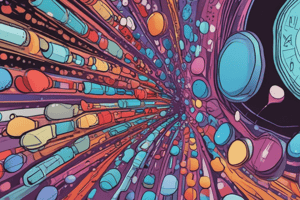Podcast
Questions and Answers
What is the main focus of pharmacodynamics?
What is the main focus of pharmacodynamics?
- The study of the interactions between a drug and the environment
- The study of the effects of the body on drugs
- The study of the interactions between a drug and the mind
- The study of the effects of drugs on the body (correct)
What is the term for the strength of the bond between a drug and its receptor?
What is the term for the strength of the bond between a drug and its receptor?
- Binding affinity (correct)
- Potency
- Intrinsic activity
- Receptor binding
What type of dose-response relationship shows a graded response to increasing doses of a drug?
What type of dose-response relationship shows a graded response to increasing doses of a drug?
- Linear dose-response
- All-or-nothing response
- Quantal dose-response
- Graded dose-response (correct)
What is the term for the way a drug produces its therapeutic effect?
What is the term for the way a drug produces its therapeutic effect?
What is the term for the effects of a drug on the body that are not related to the drug's therapeutic effect?
What is the term for the effects of a drug on the body that are not related to the drug's therapeutic effect?
What is the term for the measure of a drug's safety and efficacy?
What is the term for the measure of a drug's safety and efficacy?
Flashcards are hidden until you start studying
Study Notes
What is Pharmacodynamics?
- The study of the effects of drugs on the body
- Examines the interactions between a drug and its target molecules, organs, and systems
- Focuses on the mechanisms of action, dose-response relationships, and therapeutic effects of drugs
Key Concepts
Receptors
- Proteins that bind to drugs and trigger a response
- Types: agonists, antagonists, inverse agonists, and allosteric modulators
- Binding affinity: the strength of the bond between a drug and its receptor
- Intrinsic activity: the ability of a drug to activate a receptor
Dose-Response Relationships
- The relationship between the dose of a drug and its effect on the body
- Types: graded dose-response, quantal dose-response, and all-or-nothing response
- Factors influencing dose-response: potency, efficacy, and receptor binding
Mechanisms of Action
- The way a drug produces its therapeutic effect
- Types: receptor-mediated, non-receptor-mediated, and enzyme-mediated
- Examples: agonism, antagonism, inhibition, and activation
Pharmacological Effects
- The effects of a drug on the body
- Types: therapeutic, adverse, and idiosyncratic effects
- Factors influencing pharmacological effects: patient factors, drug factors, and disease state
Therapeutic Index
- A measure of a drug's safety and efficacy
- Calculated by dividing the median toxic dose (TD50) by the median effective dose (ED50)
- Higher therapeutic index indicates a safer and more effective drug
Pharmacodynamic Interactions
- The interactions between multiple drugs and their effects on the body
- Types: synergistic, antagonistic, and additive interactions
- Factors influencing pharmacodynamic interactions: pharmacokinetics, receptor binding, and enzymatic activity
Pharmacodynamics
- Study of the effects of drugs on the body
- Examines interactions between a drug and its target molecules, organs, and systems
- Focuses on mechanisms of action, dose-response relationships, and therapeutic effects of drugs
Receptors
- Proteins that bind to drugs and trigger a response
- Types: agonists, antagonists, inverse agonists, and allosteric modulators
- Binding affinity: strength of the bond between a drug and its receptor
- Intrinsic activity: ability of a drug to activate a receptor
Dose-Response Relationships
- Relationship between the dose of a drug and its effect on the body
- Types: graded dose-response, quantal dose-response, and all-or-nothing response
- Factors influencing dose-response: potency, efficacy, and receptor binding
Mechanisms of Action
- Way a drug produces its therapeutic effect
- Types: receptor-mediated, non-receptor-mediated, and enzyme-mediated
- Examples: agonism, antagonism, inhibition, and activation
Pharmacological Effects
- Effects of a drug on the body
- Types: therapeutic, adverse, and idiosyncratic effects
- Factors influencing pharmacological effects: patient factors, drug factors, and disease state
Therapeutic Index
- Measure of a drug's safety and efficacy
- Calculated by dividing the median toxic dose (TD50) by the median effective dose (ED50)
- Higher therapeutic index indicates a safer and more effective drug
Pharmacodynamic Interactions
- Interactions between multiple drugs and their effects on the body
- Types: synergistic, antagonistic, and additive interactions
- Factors influencing pharmacodynamic interactions: pharmacokinetics, receptor binding, and enzymatic activity
Studying That Suits You
Use AI to generate personalized quizzes and flashcards to suit your learning preferences.



